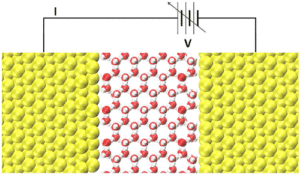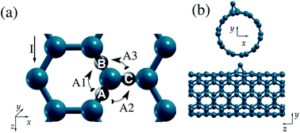Predicting the chemical reactions taking place at an electrified interface between a metal and a liquid is a long-standing challenge in materials modelling. This requires an accurate description of a liquid solution and its interface with the metal (e.g. double layer formation). Most importantly it requires treating the problem as an open-boundary conditions one, where the electrostatic potential in the cell is set by an external circuit. In the last few years we have used our density functional theory open-boundary condition method, developed originally for quantum transport, to tackle the electrochemical problem. This involves performing ab initio molecular molecular dynamics in the presence of an electrical current and an external potential. Here are a few on-going projects in this area:
Solid-liquid interfaces from first principles
 The description of electrified liquid/solid interfaces, including possible interface chemical reactions, is key to tackle electrochemistry from a theoretical point of view. The non-equilibrium quantum transport theoretical framework implemented through the Green’s function method and density functional theory electronic structure is an ideal platform for tackling such problem. In this case, in fact, the external potential is set by the boundary conditions so that the description of an electric field across an electrochemical cell does not require to use charge cells or complex periodic potentials. The availability of current-induced forces then allows us to perform ab initio molecular dynamics in this framework, namely under current-carrying conditions. This effectively opens a new exacting avenue to theoretical electrochemistry. At present we are directing research into two different directions. On the one hand, we are interfacing our Smeagol transport code with the CP2K DFT platform, which is specifically designed for molecular dynamics. On the other hand, we have addressed a few simpler problems where electronic tunnelling through liquids is described by performing large ensemble averages over configurations obtained from molecular dynamics simulations.
The description of electrified liquid/solid interfaces, including possible interface chemical reactions, is key to tackle electrochemistry from a theoretical point of view. The non-equilibrium quantum transport theoretical framework implemented through the Green’s function method and density functional theory electronic structure is an ideal platform for tackling such problem. In this case, in fact, the external potential is set by the boundary conditions so that the description of an electric field across an electrochemical cell does not require to use charge cells or complex periodic potentials. The availability of current-induced forces then allows us to perform ab initio molecular dynamics in this framework, namely under current-carrying conditions. This effectively opens a new exacting avenue to theoretical electrochemistry. At present we are directing research into two different directions. On the one hand, we are interfacing our Smeagol transport code with the CP2K DFT platform, which is specifically designed for molecular dynamics. On the other hand, we have addressed a few simpler problems where electronic tunnelling through liquids is described by performing large ensemble averages over configurations obtained from molecular dynamics simulations.
References:
[2] Clotilde S. Cucinotta, Ivan Rungger, and Stefano Sanvito. First principles study of electron tunneling through ice. J. Phys. Chem. C 116, 22129 (2012). [1] I.Rungger, X.Chen, Udo Schwingenschloegl, and Stefano Sanvito. Finite-bias electronic transport of molecules in water solution. Phys. Rev. B 81, 235407 (2010).
Current-induced effects in molecular junctions
 It is possible to demonstrate that the forces acting on the nuclei due to the action of a steady-state current can be calculated with an equivalent Hellmann–Feynman theorem, where the equilibrium charge density is replaced by the non-equlibrium one. Such scheme is implemented in our quantum transport code Smeagol, which can then address problems concerning the interplay between currents and ionic motion. In particular we are capable of investigating reaction barriers and phonons in nano-scale systems under current-carrying conditions. In the last few years we have looked at the reduction of the potential barrier for migration of adatoms on carbon surfaces (graphene and nanotubes) due to a current and identified the main feature affecting such motion. In general this depends on the distribution of the local bond currents and atoms placed at different positions can experience very different barriers due to their particular symmetry. At the same time we have investigated the change in the phonon spectrum of elementary molecules sandwiched in nano-scale junctions under the action of the current. Again we have demonstrated that a current can either soften or harden a given phonon mode depending on its symmetry. Results are usually rationalized in terms of simple oscillators models with parameters depending on the current intensity and based on chemical bond theory.
It is possible to demonstrate that the forces acting on the nuclei due to the action of a steady-state current can be calculated with an equivalent Hellmann–Feynman theorem, where the equilibrium charge density is replaced by the non-equlibrium one. Such scheme is implemented in our quantum transport code Smeagol, which can then address problems concerning the interplay between currents and ionic motion. In particular we are capable of investigating reaction barriers and phonons in nano-scale systems under current-carrying conditions. In the last few years we have looked at the reduction of the potential barrier for migration of adatoms on carbon surfaces (graphene and nanotubes) due to a current and identified the main feature affecting such motion. In general this depends on the distribution of the local bond currents and atoms placed at different positions can experience very different barriers due to their particular symmetry. At the same time we have investigated the change in the phonon spectrum of elementary molecules sandwiched in nano-scale junctions under the action of the current. Again we have demonstrated that a current can either soften or harden a given phonon mode depending on its symmetry. Results are usually rationalized in terms of simple oscillators models with parameters depending on the current intensity and based on chemical bond theory.
